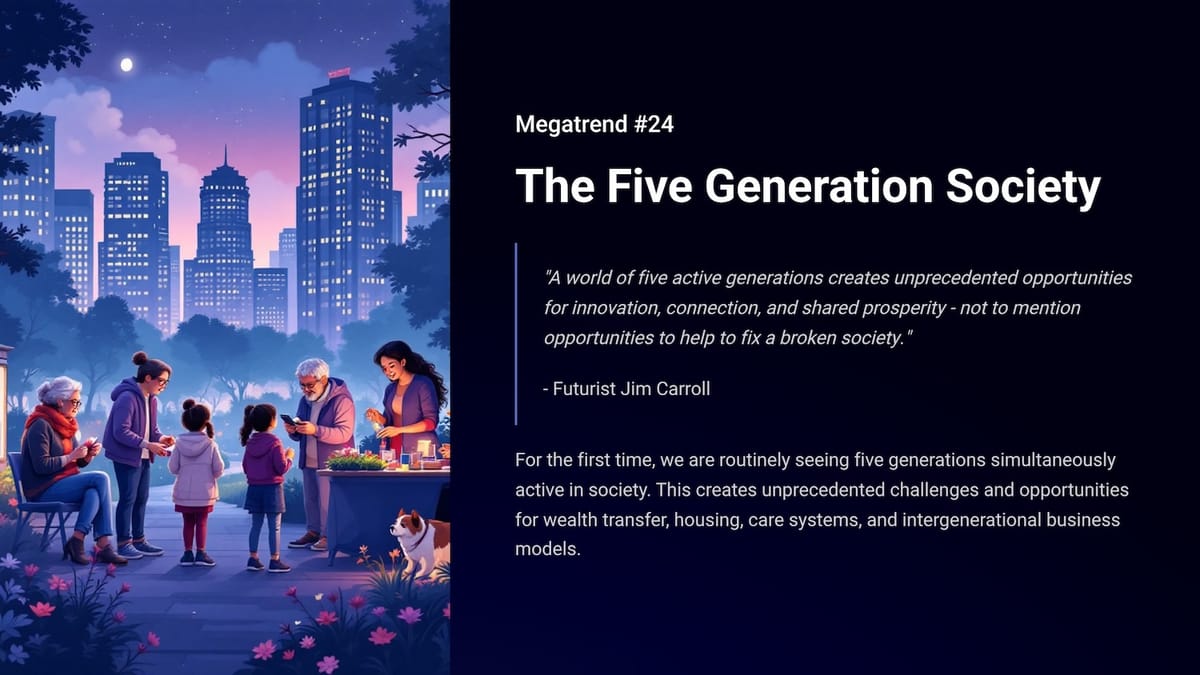"A world of five active generations creates unprecedented opportunities for innovation, connection, and shared prosperity - not to mention opportunities to help to fix a broken society." - Futurist Jim Carroll

(Futurist Jim Carroll is writing a series on 30 Megatrends, which he first outlined in his book Dancing in the Rain: How Bold Leaders Grow Stronger in Stormy Times. The trends were shared in the book as a way of demonstrating that, despite any period of economic volatility, there is always long-term opportunity to be found. The book is now in print - learn more at dancing.jimcarroll.com)
For those who personally know me, this post marks a remarkable moment in my own life. It's uncanny that this post would appear in the megatrend sequence. Welcome, Mason James!
What's the trend? For the first time, we are routinely seeing five generations simultaneously active in society. This creates unprecedented challenges and opportunities for wealth transfer, housing, care systems, and intergenerational business models. It's a pretty significant trend, and one often not covered. If you'd like, you can dig it in more depth in my report, The Five-Generation Society: Navigating the Global Challenges and Opportunities of Intergenerational Expansion (2025-2035). Here's the PDF.
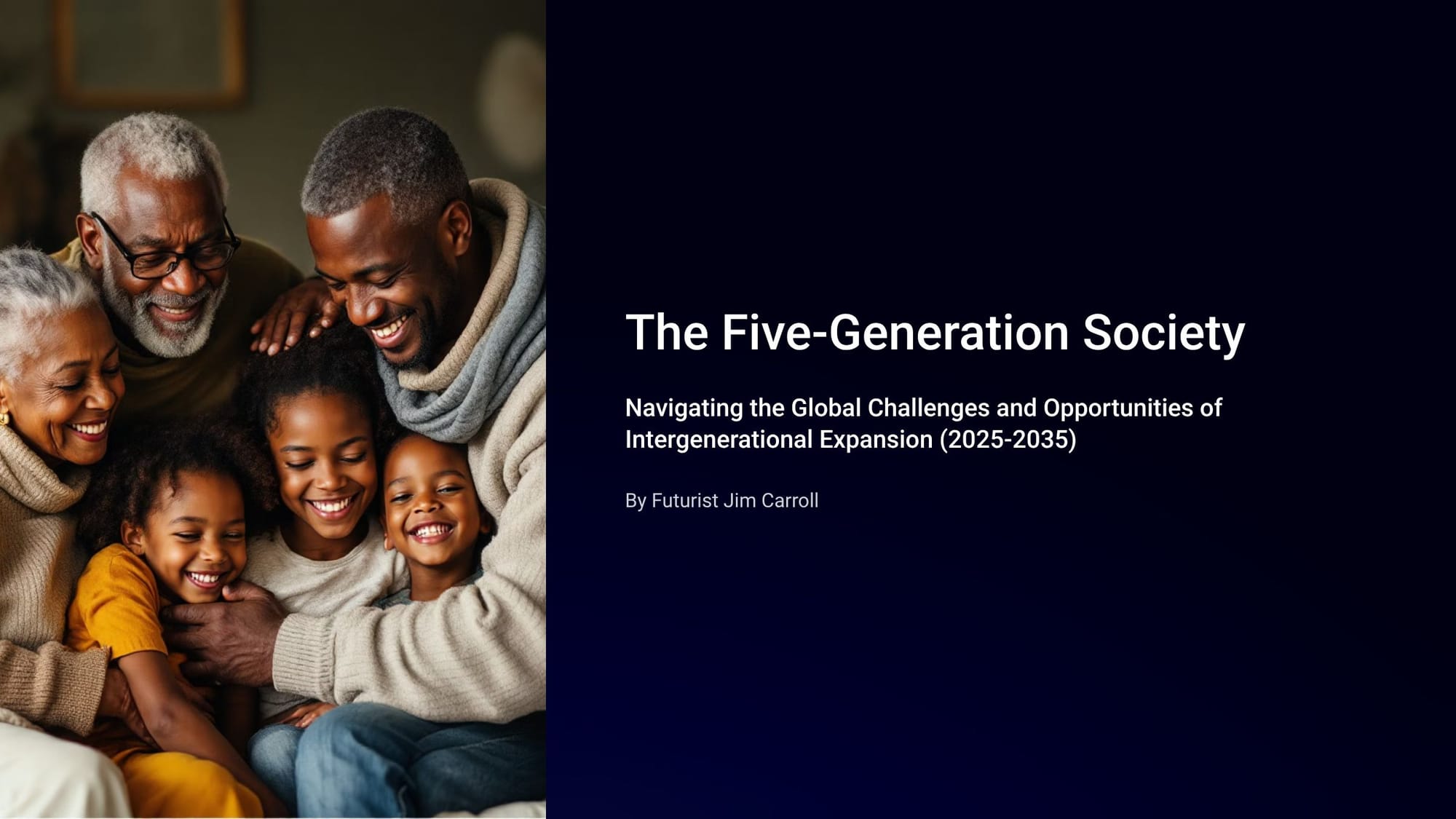
We are, globally, in the midst of an unprecedented demographic shift. For the first time in human history, five distinct generations are simultaneously active in society at scale, creating a demographic phenomenon that is fundamentally reshaping wealth transfer, housing, care systems, and business models worldwide.
The simple fact is, while wonderfully inspiring, the trend presents some pretty significant systemic challenges.
Existing models for wealth transfer, housing, and care are inadequate for supporting a larger, older population while meeting the needs of younger people, creating potential for social friction and conflict over resources. It' an extraordinary opportunity, though, in that this demographic shift is fueling a multi-trillion-dollar "Longevity Economy" and a booming "AgeTech" market projected to reach $120 billion by 2030, precipitating the largest intergenerational wealth transfer in history.

There are some pretty simple demographic and scientific trends at work here:
- Unprecedented gains in longevity have extended life far beyond historical norms.
- Simultaneous decline in fertility rates has altered the balance between young and old.
- Global population structure is transitioning from a pyramid to a rectangular shape.
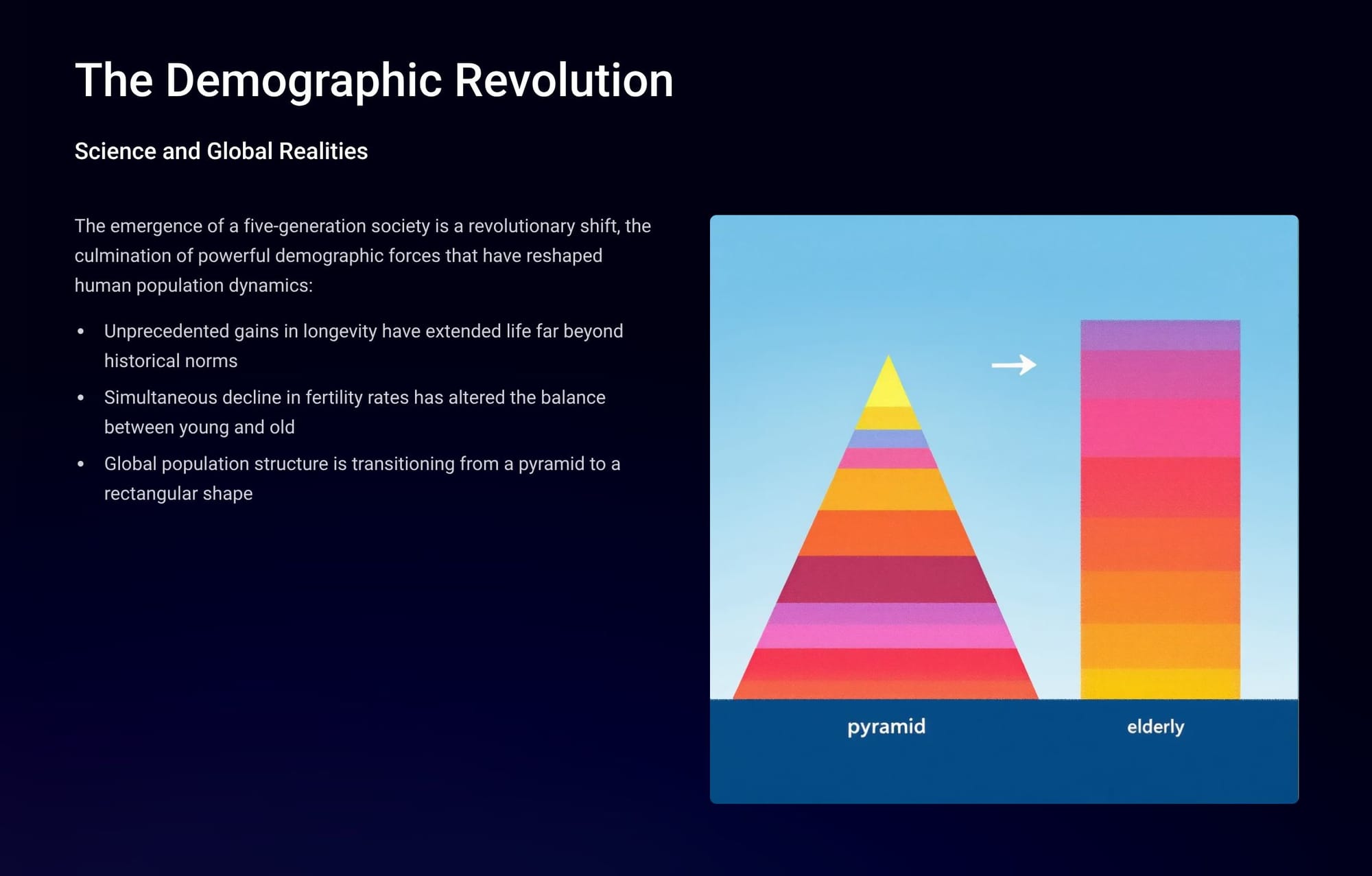
And in that trend are some subtle and significant regional differences:
- Rapidly aging societies: Japan is the world's most aged society, with 29.1% of its population over 65. By 2075, Germany's old-age dependency ratio will surge from 42.4 to 63.1, and Spain's from 35.4 to 70.4.
- Rapidly Transforming Regions. Asia-Pacific's population over 60 will surge from 13.6% in 2020 to 25% by 2050, representing 1.3 billion people. China's population peaked in 2021 and is projected to decline by 200 million by 2054.
- Youthful, High-Growth Regions. Countries in Africa retain a more traditional pyramid shape, presenting the potential for a "demographic dividend." This creates a new dynamic where labor shortages in the aging Global North are increasingly met by talent from the youthful Global South.
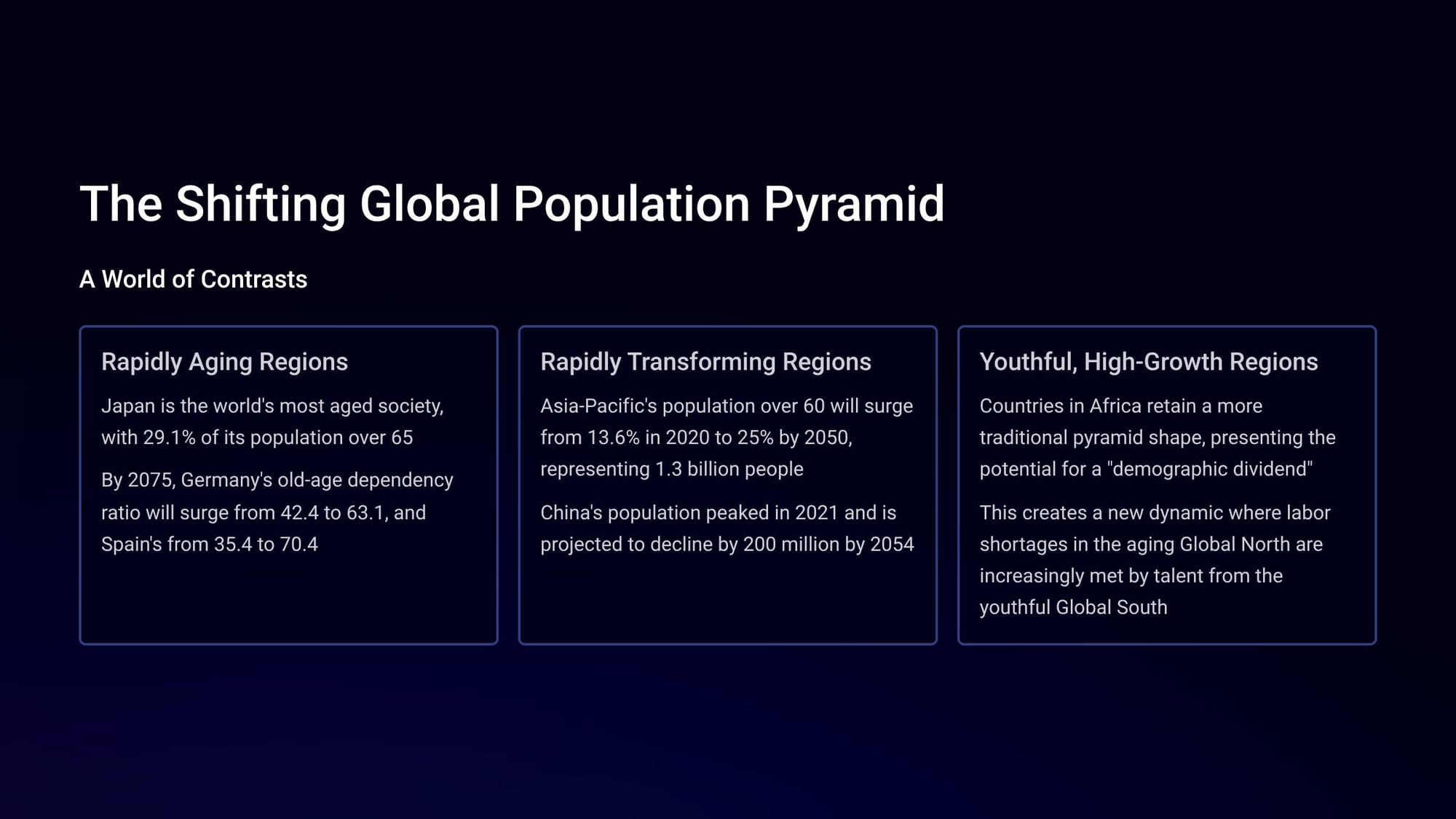
To understand the trend, you need to define the generations - the years they were born, the context of their formative years, and their relationship with work and tech.
Silent Generation
- <1946. Great Depression, WWII.
- Loyalty, Discipline, Hierarchy.
- Digital Immigrants
Baby Boomers.
- 1946-1964. Cold War,
- Economic Boom.
- Work-Centric, Competitive.
- Digital Adopters
Generation X.
- 1965-1980 End of the Cold War,
- Rise of PCs.
- Independence, Work-Life Balance.
- Digital Pioneers
Millennials (Gen Y).
- 1981-1996.
- 9/11, Rise of the Internet
- Purpose, Collaboration, Feedback
- Digital Natives
Generation Z
- 1997-2012
- Smartphones, COVID-19
- Authenticity, Diversity, Pragmatism
- Hyper-Digital
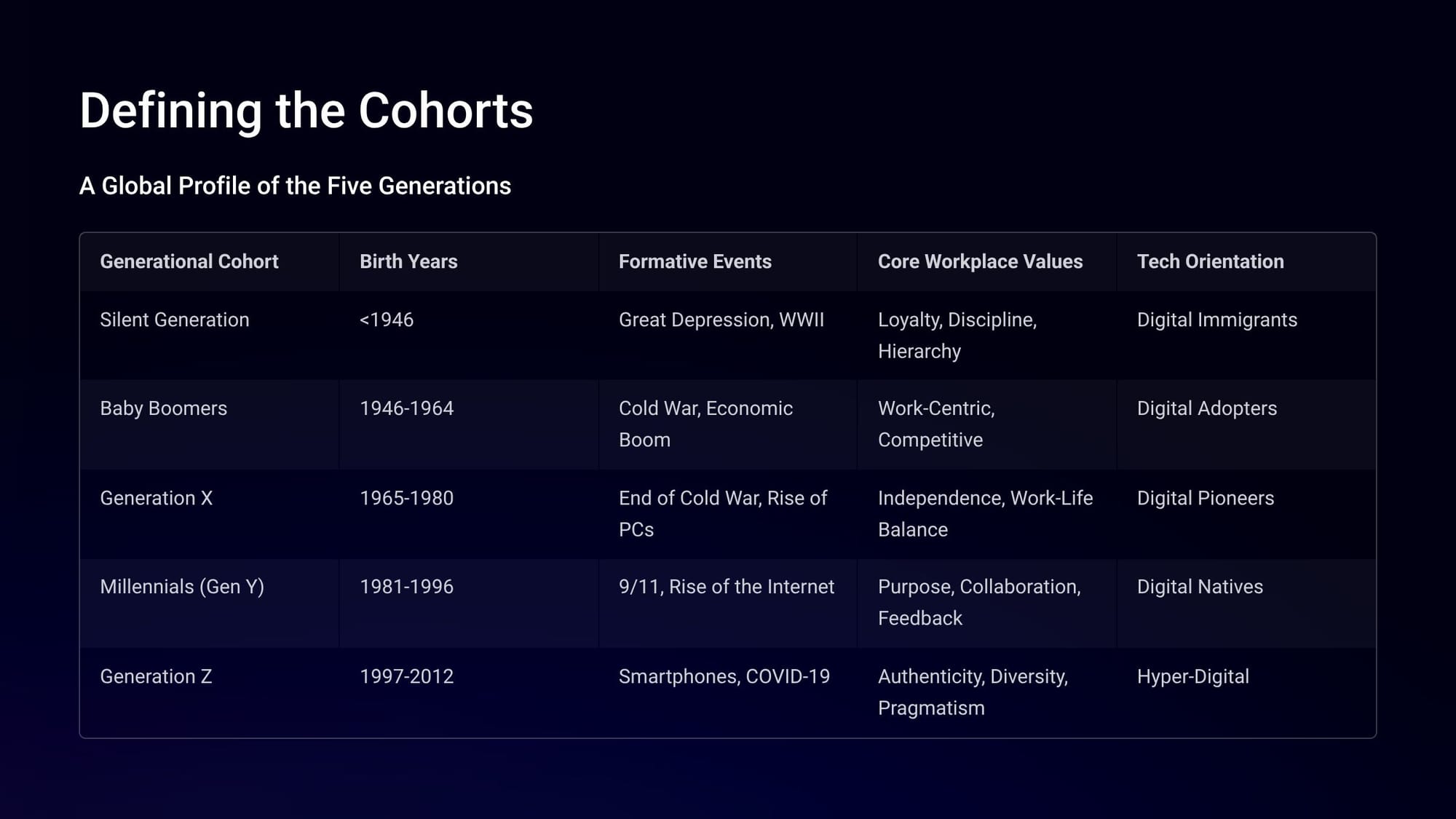
All of this means that we need a new 'social contract' for managing this complex new world - one that involves breaking the traditional three-stage life of education, work, and a short retirement. This involves:
- Sustainable Social Security: Reform systems to ensure long-term viability.
- Universal Access to Savings: Guaranteed lifetime income solutions.
- Lifelong Learning: Continuous education and reskilling.
- Flexible Work Options: Adaptable careers and retirement paths.
- Accessible Healthcare: Focus on prevention and healthy aging.
- Age-Friendly Communities: Designed for all ages and abilities.
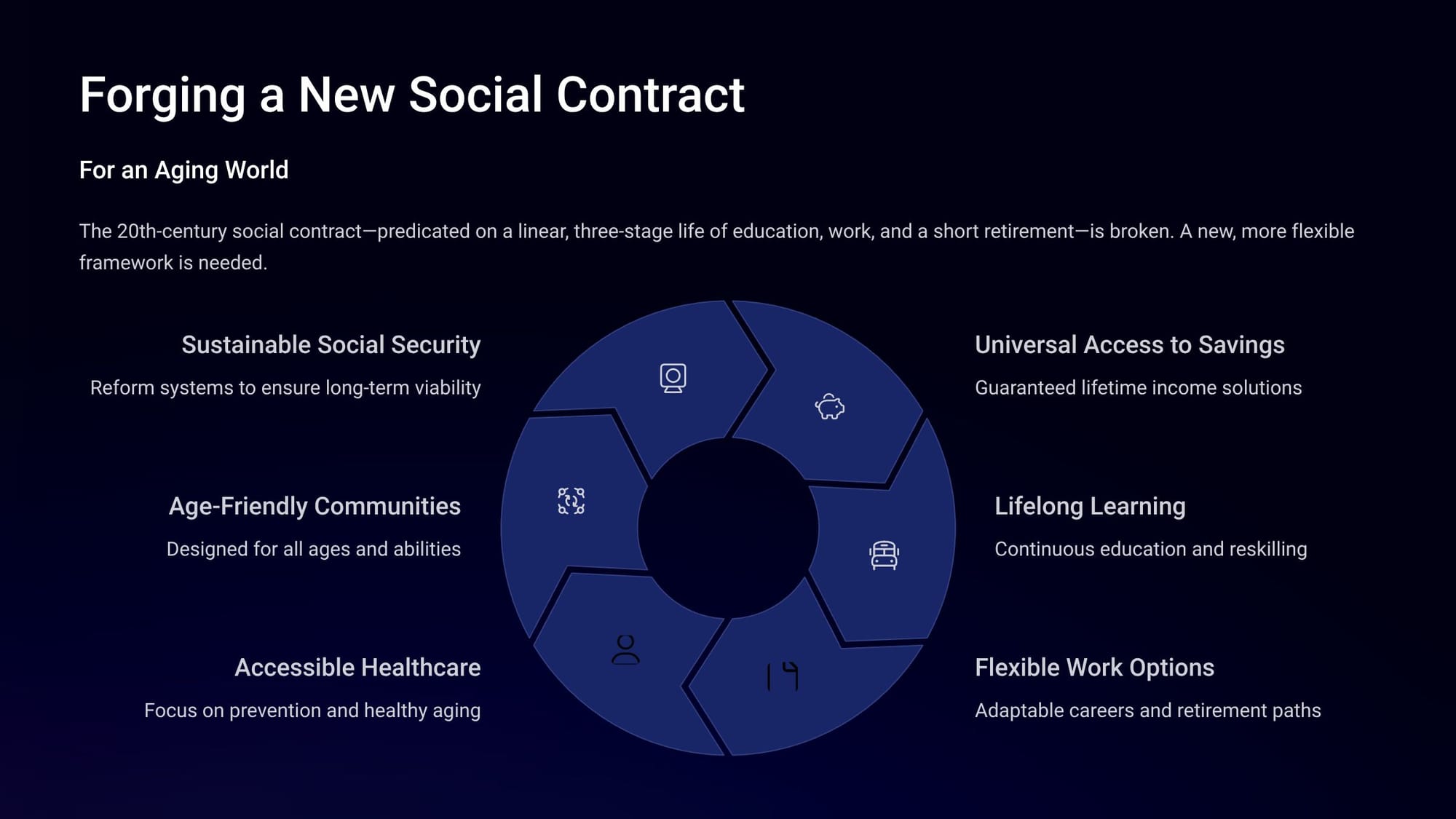
Within this trend is "The Great Wealth Transfer," as money moves from older generations to younger generations. It's the largest intergenerational transfer of wealth in history:
- An estimated $124 trillion in assets will change hands through 2048.
- Annual transfers in the US alone average $350 billion.
- Baby Boomers are expected to bequeath $53 trillion, while the Silent Generation will transfer $15.8 trillion.
- Primary recipients will be Gen X ($39 trillion) and Millennials ($46 trillion).
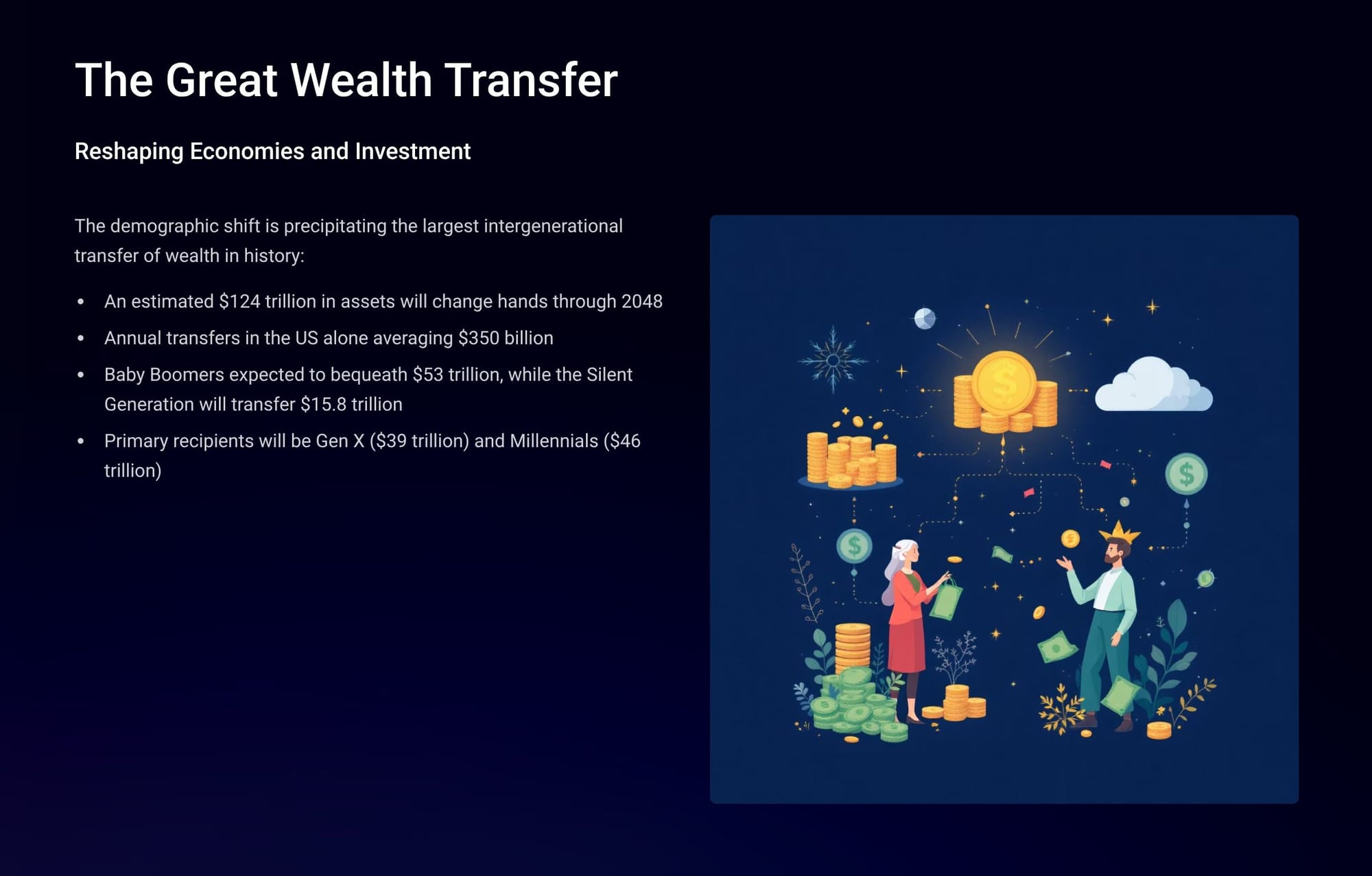
The numbers become truly staggering when examined in a global context:
- $124T Global Wealth Transfer: Total assets changing hands through 2048.
- $350B Annual US Transfers: Average yearly wealth movement in America.
- $3.5T European Transfer: Estimated wealth transfer by 2030.
- $5.8T Asia-Pacific Transfer: Projected wealth movement by 2030.
North America will see the largest transfer in absolute terms, but it is poised to become a "Great Inequality Transfer,"as white Baby Boomers hold over 90% of their generation's wealth, potentially deepening the racial wealth gap.
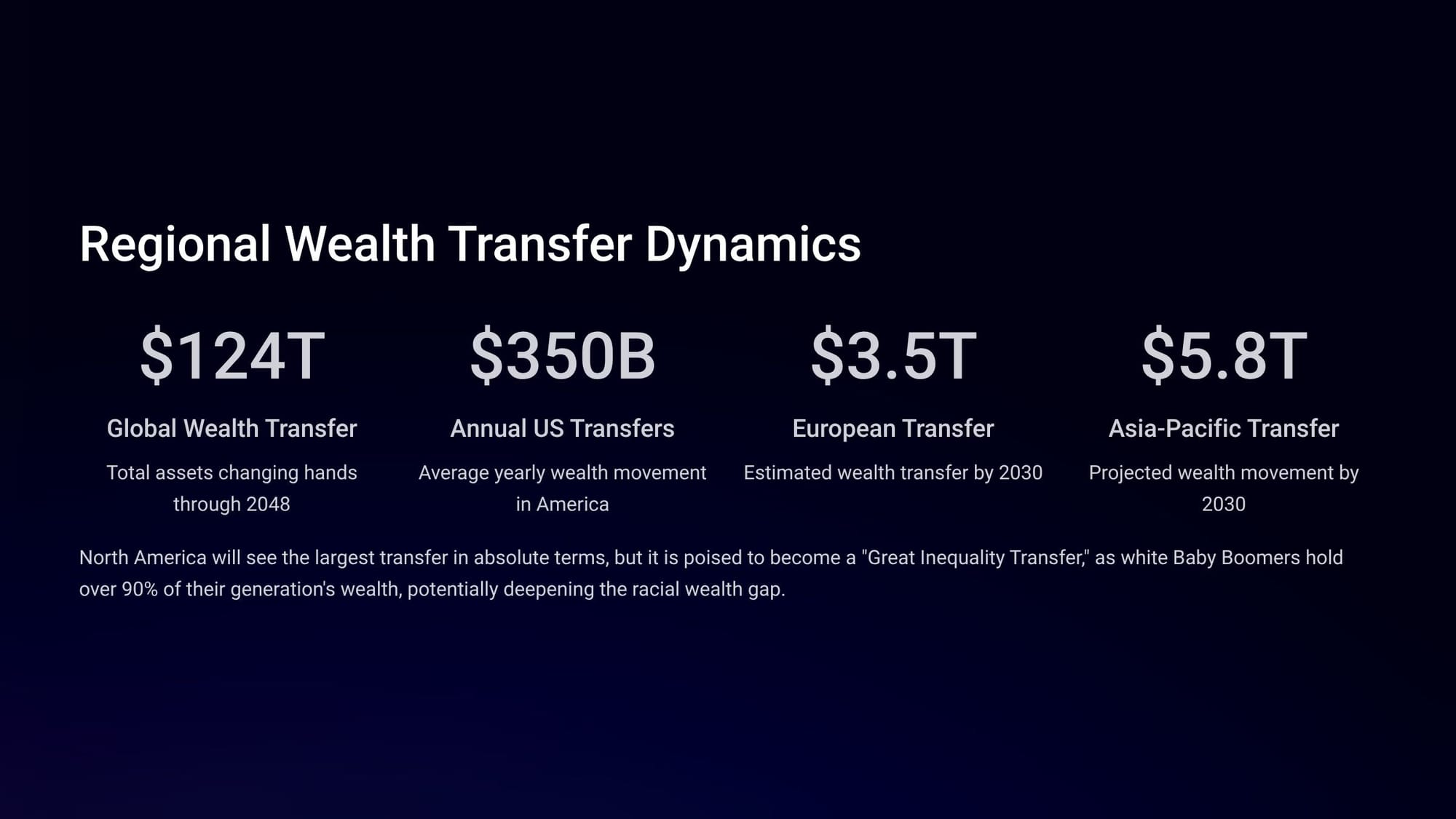
So, what does all of this lead to? Opportunity!
For example, we are busy imagining the idea of housing, building it for all ages. The fact is, the five-generation society is placing immense strain on a global housing stock designed for the 20th-century nuclear family, with these trends at work:
- Older adults seeking to age in place.
- Younger generations are struggling with affordability.
- Growing demand for intergenerational living solutions.

Why is this critical? The aging of the global population is creating a global care crisis, with demand for eldercare and childcare outstripping the supply of caregivers:
- By 2035, older adults will constitute roughly a quarter of the population in many developed nations.
- WHO projects a 10.2 million health worker shortage by 2030.
- Nearly $600 billion informal caregiving economy, largely shouldered by the "sandwich" Generation X.
There is a lot of opportunity within this trend to reimagine the idea of seniors' care.
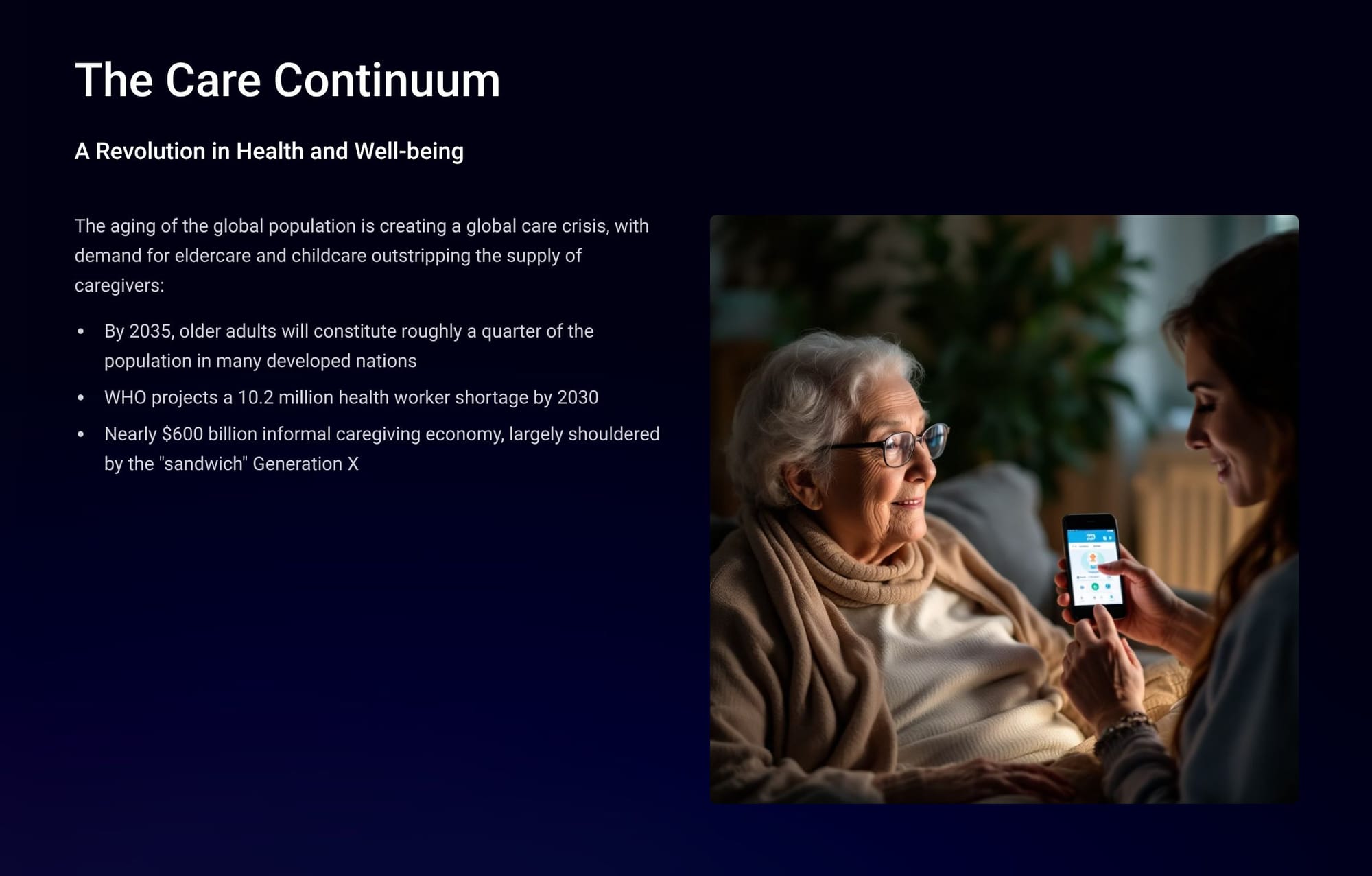
And much of that opportunity involves rethinking the role of tech:
- AI and Personalized Care. AI-powered passive sensing systems and companion avatars will move from niche to mainstream, providing monitoring and psychosocial support without intrusive wearables.
- Remote Health and Telemedicine. Wearable devices will evolve into sophisticated personal health navigators, while remote patient monitoring becomes standard for managing chronic diseases.
- Smart Homes for Independence. The Internet of Things (IoT) will transform homes into responsive environments that support aging in place with voice assistants, fall detectors, and automated systems.
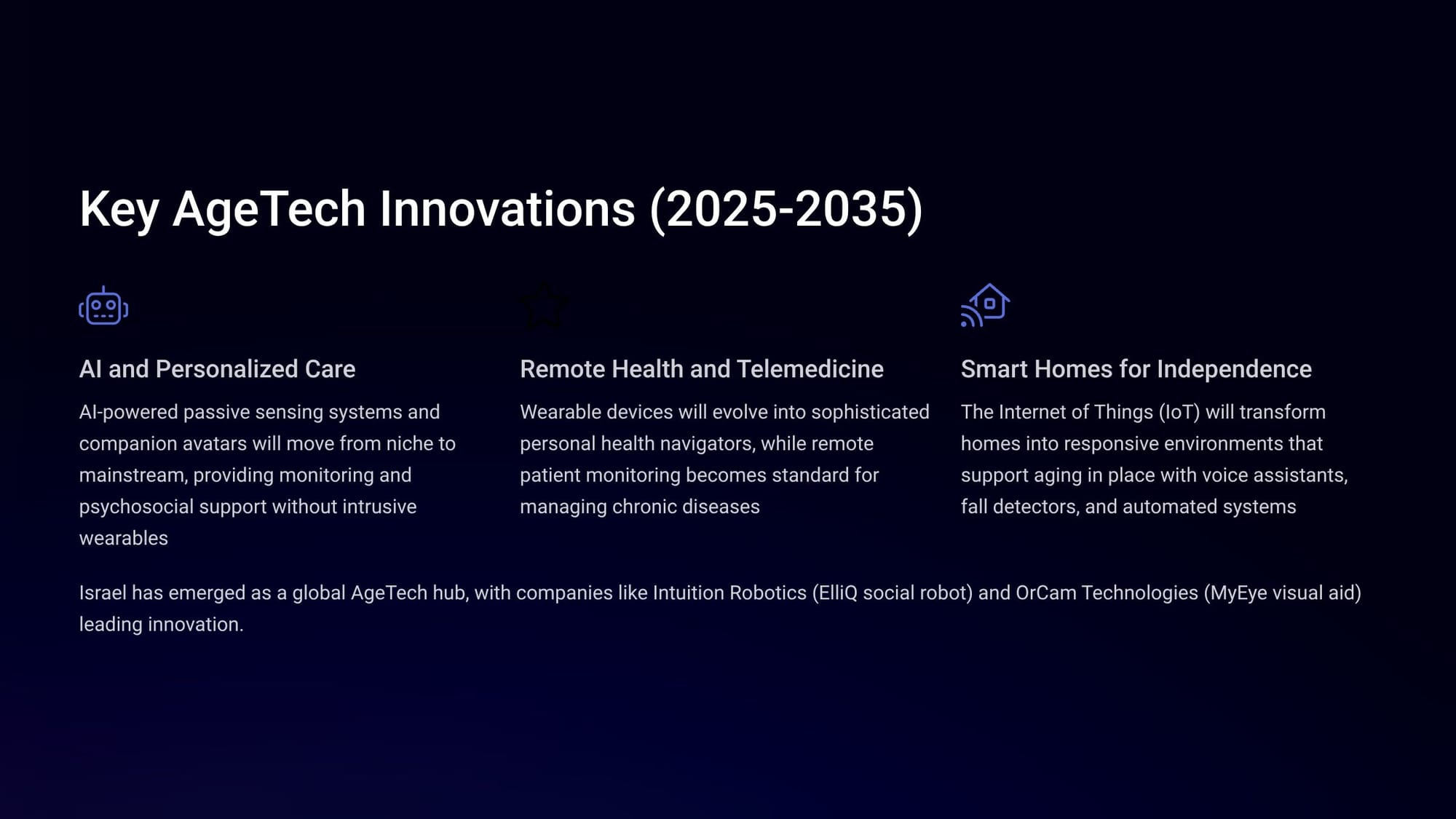
There are also many thinking about the "Intergenerational Enterprise", as the arrival of the five-generation society is reconfiguring the world of work and commerce:
- Transforming internal organizational dynamics
- Creating vast new external markets
- Driving innovation in business models
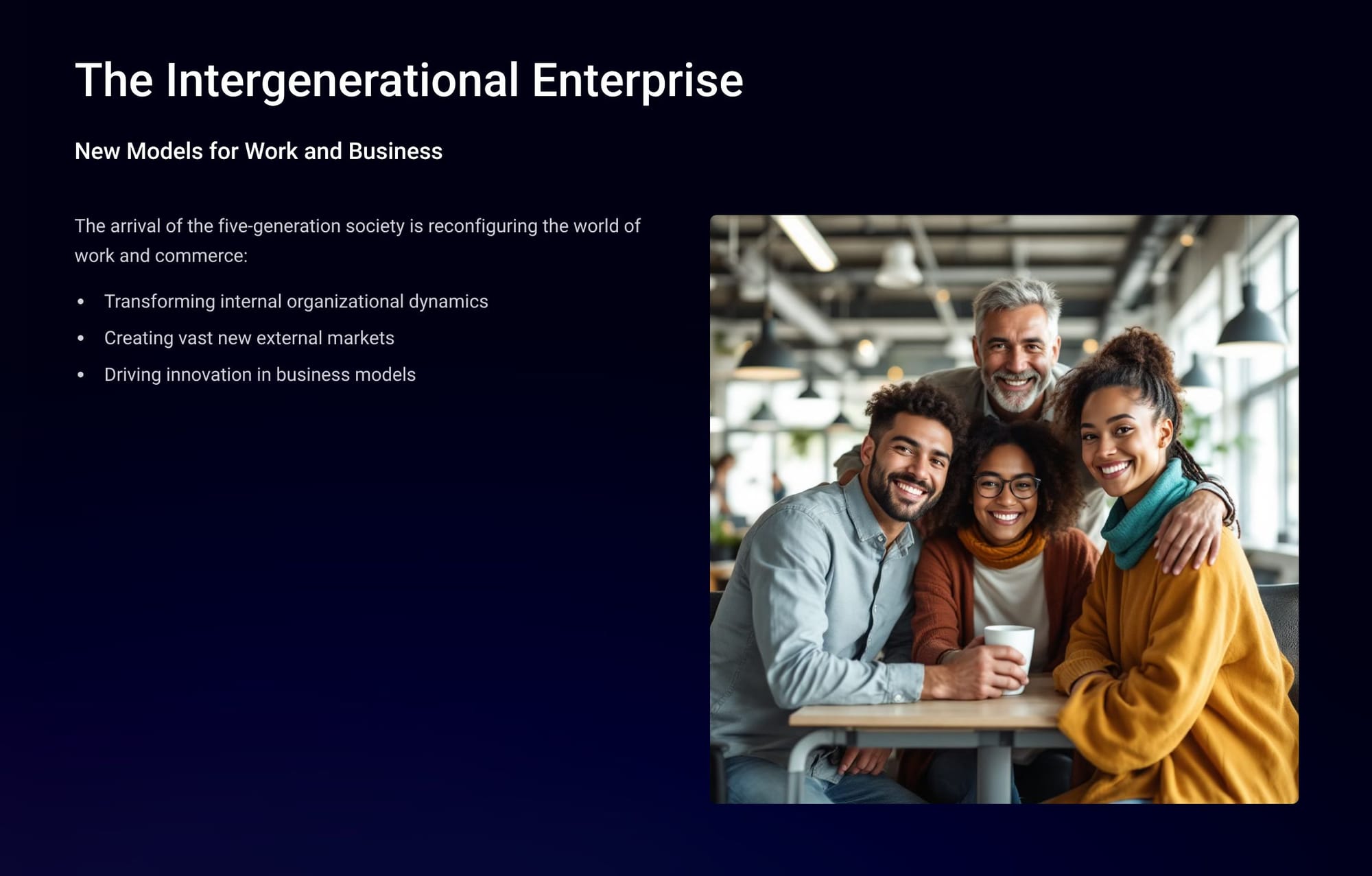
A lot of this involves the arrival, for the first time, of the "five-generation workforce!"
- Workforce Composition. By 2030, Millennials and Gen Z will form the majority of the global workforce, making their expectations the new standard. One of the most urgent challenges is the "knowledge crash" risk, as retiring Baby Boomers take decades of invaluable institutional knowledge with them.
- Knowledge Transfer Strategies. Mentorship and Reverse Mentorship: Formal programs where experienced workers guide younger employees, and tech-savvy younger employees coach senior colleagues on digital tools.
- Intergenerational Teaming: Intentionally creating age-diverse teams to combine deep institutional knowledge with digital fluency.
- Leadership Evolution. Leaders must adapt, moving from hierarchical command-and-control to a coaching-oriented approach. Research reveals that different generations are "remarkably similar" in their core work preferences, suggesting a focus on individual needs over generational labels.
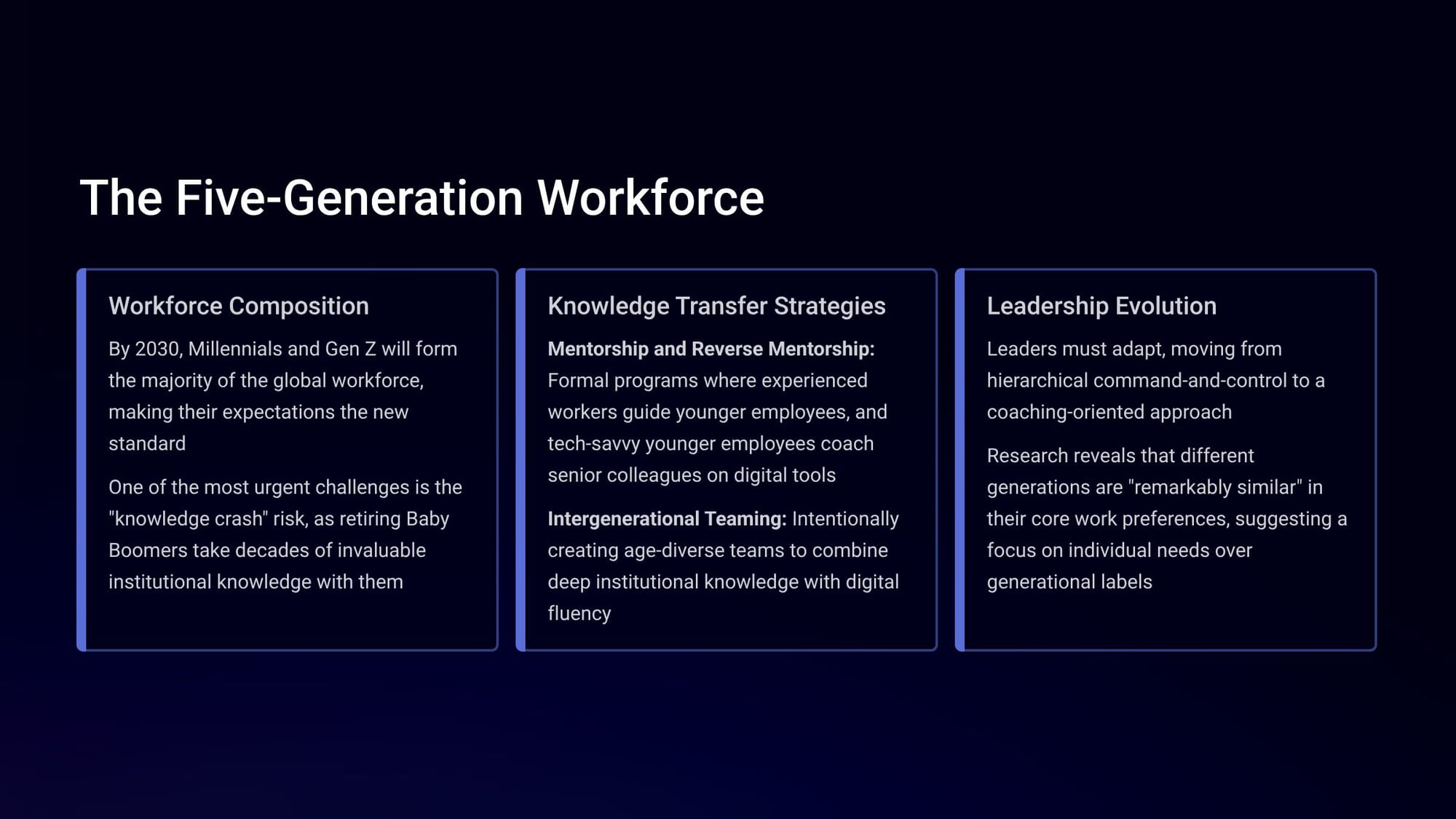
The thing is - this is all evolving VERY QUICKLY:
2025-2028: The Acceleration Phase
- The "knowledge transfer crisis" will come to a head as Boomer retirements accelerate.
- Millennials will solidify their dominance in the workforce, embedding their preferences for flexibility into corporate culture.
- The AgeTech market will see significant consolidation and mainstream adoption of AI-driven care solutions.
2029-2032: The Restructuring Phase
- The Great Wealth Transfer will hit its peak velocity, causing a measurable shift in capital toward ESG-focused funds.
- The first large-scale, purpose-built intergenerational housing projects will become operational.
- Acute fiscal pressure will force governments to implement significant reforms to pension and healthcare systems.
2033-2035: The Tipping Point
- A major demographic tipping point will be reached in the US and other Western nations as the population aged 65+ outnumbers those under 18 for the first time.
- This will cement the political power of the senior demographic.
- The concept of a linear career will be largely replaced by a fluid, multi-stage model of work, learning, and leisure.

And as for Mason?
As they say, "Oh, the places he'll go, and the things he will see!"
“Papa” Jim Carroll has a nice ring, don’t you think?

